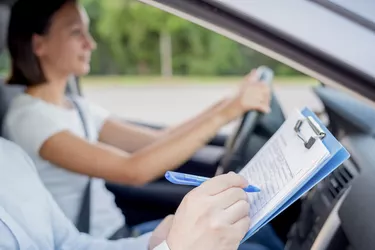
Ohio uses two driving tests to assess your skill behind the wheel: a road test and a maneuverability test. While the road test examines your ability to drive in traffic, obey the rules of the road and adjust your speed to conditions, the maneuverability test requires you to show how well you negotiate around objects and tight spaces, handle the car in reverse and judge distances. The simple course layout belies the skill needed to complete it without amassing the point deductions that can lead to failure. Prepare for the Ohio maneuverability test by learning some basic tips and practicing the skills you'll need to show.
Understand the Driving Cone Test
Video of the Day
Get a feel for what you'll face when you enter the maneuverability course. You start the course in a space similar to a one-car garage with an opening that's about 9-feet wide, according to the Ohio Bureau of Motor Vehicles. Four cones mark the corners of a 9-ft. by 20-ft. rectangle directly in front of this starting space. You are expected to center your car in the starting area and align the front bumper with the first set of cones.
Video of the Day
Twenty-feet ahead of the rectangle sits a single cone in the center of the course. The examiner will ask you to drive to one side of this pivot cone. After passing it, you stop with your car straight and your rear bumper even with the cone. Repeat these movements in reverse to return to the starting point and stop in your original position.
The 20-foot distance between the various cone placements is similar to that of a parking space: Perpendicular spaces in parking lots measure about 9 feet wide by 18 feet long. Conquering the driving cone test will improve your parking skill.
Know How Your Car Handles
Take the test in the car you drove for your practice sessions. Familiarity with the car's size, steering and idle speed can give you the confidence needed to pass the test. You'll be more prepared to avoid over- or under-steering and control your speed, key driving skills needed to complete the course, according to Heights Driving School. The school's website notes that the key to proper steering lies in turning the wheel just enough to negotiate the cones.
Knowing how sensitive your car's steering is allows you to make corrections and avoid knocking over a cone or stopping at an angle. Hitting a cone costs you five points; knock one over and you fail. Best practice is to maintain a 1-foot distance from the cones.
Although you may want to finish the test quickly, don't rush. Consider going as slow as possible without coming to a stop as well as riding the brake as necessary to maintain a slow, steady speed. Stopping to check your position earns a five-point deduction.
Master Your Mirrors
Your side mirrors signal when you must turn the steering wheel during the Ohio maneuverability test. Throughout your mandatory eight hours of behind-the-wheel driving instruction and 50 hours of driving time with a parent or guardian, acquire the habit of relying on both rear and side mirrors to judge the position of your car relative to its surroundings.
Practice Your Approach
Although Ohio requires your driving instructor to give you at least a 30-minute lesson on the Ohio maneuverability test, you may need more preparation time. Your high school, driving school or local AAA office may have a maneuverability course on its property available for practice. You also can set up your own course according to the diagram found in your Ohio Driver's Manual.
Think of your steering wheel as a circle, so you can use a half circle/full circle method to navigate the cones: Half circle turning at the cones in front of the start box, then a full circle turning at the pivot cone. The direction for this sequence depends on whether the examiner tells you to go right or left, and if you are at the first or second part of the test.
When the examiner tells you to begin and go right, watch your right-hand mirror. When this mirror lines up with the cone on the right, turn the steering wheel to the right one half turn, or half circle. Continue driving, keeping your eye on the driver-side mirror. When that mirror is even with the cone, turn the wheel left one full circle, or 360 degrees. Bring the car to a stop once the rear bumper lines up with the pivot cone.
Do the opposite to return to the start of the course. Take your time and put the car in reverse without moving the wheel. Back slowly until the mirror on your side is even with the pivot cone. Turn the wheel one full circle, or 360 degrees, to the right without stopping. As soon as the passenger-side mirror is even with the next cone, make a half-circle turn to the left. Cruise to a stop when you reach your original starting position.